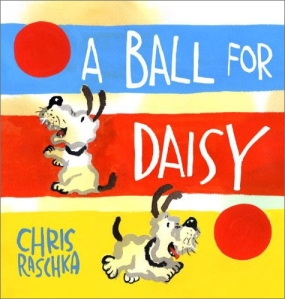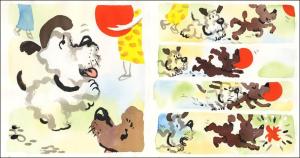Taback, Simms. 1997. THERE WAS AN OLD LADY WHO SWALLOWED A FLY. New York: Viking Penguin. ISBN 978-0670869398
Simms Taback brings the classic folktale about a little old lady’s disturbing eating habits to new life in his modern retelling of THERE WAS AN OLD LADY WHO SWALLOWED A FLY. This tale includes the traditional cast of characters: fly, spider, bird, cat, dog, cow, and horse. The story also follows its predictable conclusion (she died, of course). However, the vibrant illustrations, interspersed additional facts, and witty animal commentary make Taback’s version of this story unique.
This Caldecott Honor book is gorgeously illustrated and includes a peek-a-boo die-cutout view of the Old Lady’s stomach as she munches her way through a menagerie. The graphics in this retold tale are boldly colored and have “the look of a ransom note” (Kirkus Reviews 1997). The distressed and “digested wide-eyed animals float in a confetti-dusted space (which matches her dress)” after being swallowed by the Old Lady (Publishers Weekly 1997). The Old Lady takes on an increasingly large and humorously zany appearance as the story progresses. A Publisher’s Weekly starred review stated, “everything about the elderly woman’s exterior is equally askew, including the pupils in her eyes” (Publishers Weekly 1997).
Enrichment Activities:
THERE WAS AN OLD LADY WHO SWALLOWED A FLY is a popular rhyming tale that can be told orally in a familiar sing-song format. The oral repetition of a familiar rhyme, read aloud from a storybook, “helps validate children’s experiences, connect written and oral expression, and invite active, physical participation” (Vardell 2008, 102). The BBC website has a version of this traditional song, sung by Andy Day, freely available on their website (http://www.bbc.co.uk/schoolradio/subjects/earlylearning/nurserysongs/F-J/swallowed_fly). Assist children to “explore neighborhood, cultural, and language variations” by translating this rhyme and song into differing dialects (Vardell 2008, 102). For instance, the Spanish language version of this song can be found here: http://englikids.blogspot.com/2012/09/there-was-old-lady-who-swallowed-fly.html.
If you would like to listen to a humorous Simms Taback singing version of this story, you can view the following video made by Jeff Seaver:
What to Read Next:
Taback, Simms. 1999. JOSEPH HAD A LITTLE OVERCOAT. New York: Viking Penguin. ISBN 978-0670878550
Pierce, Jason. 2012. THERE WAS AN OLD FLY WHO SWALLOWED A LADY. Bend, OR: 2Toad. ISBN 978-0985077310
References
Kirkus Reviews. 1997. “THERE WAS AN OLD LADY WHO SWALLOWED A FLY.” September 15. Accessed February 9, 2014. https://www.kirkusreviews.com/book-reviews/simms-taback/there-was-an-old-lady-who-swallowed-a-fly/.
Publishers Weekly. 1997. “THERE WAS AN OLD LADY WHO SWALLOWED A FLY.” September 1. Accessed February 9, 2014. http://www.publishersweekly.com/978-0-670-86939-8.
Vardell, Sylvia M. 2008. CHILDREN’S LITERATURE IN ACTION: A LIBRARIAN’S GUIDE. Westport, CT: Libraries Unlimited.











